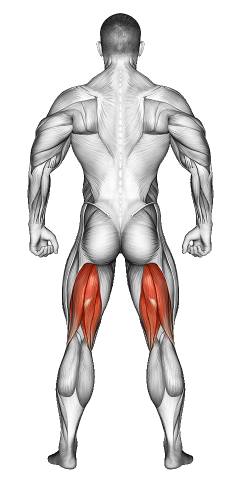Skater Jump: Video Tutorial & Exercise Guide

Written By: Claude Michael
Updated: Oct 13, 2024
| Workout | Skater Jump |
| Primary Muscle Group | Quads |
| Secondary Muscle Group | Hamstrings |
| Equipment Required | Bodyweight |
| Force Type | N/A |
| Mechanics | Compound |
| Exercise Type | Strength |
| Difficulty | Intermediate |
Skater Jump: Video Tutorial & Exercise Guide
Secondary Muscles Group
Skater Jump: Step-by-Step Guide
- Step 1: Stand with your feet hip-width apart and your knees slightly bent. Engage your core and keep your chest up.
- Step 2: Jump laterally to the right, landing on your right foot. As you land, bend your right knee to absorb the impact while keeping your left foot off the ground.
- Step 3: Swing your left leg behind you in a controlled motion, mimicking a skater’s movement, while keeping your balance on your right leg.
- Step 4: Push off with your right foot and jump laterally to the left, landing on your left foot, and repeat the same motion on the opposite side.
- Step 5: Continue alternating sides in a smooth, controlled manner, focusing on maintaining balance and control during each jump.
Skater Jump: Overview
The Skater Jump, also known as the Lateral Bound, is a plyometric exercise designed to improve lower body strength, agility, and balance. This movement mimics the lateral motion of a speed skater, making it excellent for developing coordination and athletic performance. It targets the glutes, quads, hamstrings, and calves while also engaging the core for stability.
This exercise is highly functional and can be used in both strength training and cardio routines, helping improve your explosive power and conditioning.
Skater Jump: Benefits
Skater Jumps help enhance lateral movement, which is crucial for sports that require agility and quick direction changes. This exercise strengthens the lower body muscles, particularly the glutes, quads, and hamstrings, while improving core stability and balance. The lateral bounding motion also increases cardiovascular endurance, making it an effective conditioning exercise.
In addition, Skater Jumps help develop coordination and footwork, making it an excellent addition to athletic training programs for sports like soccer, basketball, and tennis.
Skater Jump: Pro Tips & Advanced Techniques
Focus on maintaining control during each lateral jump, landing softly on your foot and bending your knee to absorb the impact. Keep your core engaged to stabilize your movements and avoid letting your torso lean forward excessively. For an extra challenge, you can hold a dumbbell or kettlebell in front of your chest or increase the distance of your jumps to improve power and agility.
Skater Jump: Progression Plan
Beginner
Intermediate
Advanced
Skater Jump: Frequently Asked Questions (FAQs)
What muscles do Skater Jumps target?
+Skater Jumps primarily target the glutes, quads, hamstrings, and calves while also engaging the core for balance and stability.
Can beginners perform Skater Jumps?
+Yes, beginners can perform this exercise by starting with smaller jumps and focusing on proper form before increasing the distance and intensity of the movement.
How can I make Skater Jumps more challenging?
+To make the exercise more challenging, increase the distance of your jumps, add weight with a dumbbell or kettlebell, or perform the movement faster to increase intensity.
What common mistakes should I avoid during Skater Jumps?
+Avoid leaning too far forward or losing control of your balance. Focus on landing softly and absorbing the impact with bent knees to prevent injury.
How often should I include Skater Jumps in my routine?
+Incorporate Skater Jumps 2-3 times per week as part of your lower-body or plyometric workout routine to improve power, agility, and balance.
Share
Don’t Wish for It, Work for It – Join the FlexXP Newsletter Today!
Thank you for signing up for the FlexXP Newsletter!
This site is protected and the Google Privacy Policy and Terms of Service apply.

